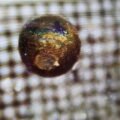The latest data from the Webb telescope suggests that the first stars formed about a hundred million years after the Big Bang when the Universe was a percent of its current age. These early nuclear reactors fused hydrogen to heavier elements, including carbon and oxygen which are essential for the chemistry of “life as we know it”, iron which is essential for making rocky planets capable of hosting liquid water on their surface, and silicon which is essential for making chips that enable artificial intelligence (AI).
After the first massive stars exploded and enriched their environments with these heavy elements, life could have started. Of course, it took billions of years for complex lifeforms to emerge on Earth and the early universe did not last that long. But microbes might have been around at high cosmological redshifts. Could we find any evidence that high-redshift microbes existed, and if so – where?
One approach is to study the oldest stars in the present-day universe and check whether they host planets around them. If they do, then the orbits of some of these planets may be oriented such that they transit the face of their host star every orbital period. These transits allow us to search for the spectral fingerprints of molecules, such as oxygen, methane, carbon dioxide, or water vapor, that would be indicative of microbial life. Of course, even if we find them – there is no guarantee that these life forms existed already hundreds of millions of years after the Big Bang. However, such a discovery would suggest that early life was possible.
And there is also “life as we do not know it”. In a recent paper, I suggested that if NASA’s Dragonfly mission in 2028 to Saturn’s richly-organic moon, Titan, will discover life in its liquid ethane and methane oceans, then life was also possible in the early universe. Titan’s surface temperature of 94 degrees Kelvin above absolute zero, matches the average temperature in the Universe after the first stars formed. When the Universe was about 90 million years old at a redshift of z=33.5, the temperature everywhere in the Universe was 94 degrees Kelvin and there was no need for a Titan-like world to be close to a star to maintain its warmth. Starting so early, high-redshift microbes could have witnessed 99% of cosmic history from up close, way better than our best telescopes.
There is so much we do not know from our limited vantage point about alternative lifeforms and what happened in our past.
For one, our cosmic horizon limits our telescopes to documenting what happened around us within the light travel time since the Big Bang, 13.8 billion years ago. We can compensate for that by developing a theory of quantum gravity that would allow us to figure out what happened before the Big Bang or beyond our cosmic horizon.
Our chemically-propelled spacecraft limit our travel horizon to a scale that is 10,000 times smaller than the cosmic horizon. We can compensate for that by studying interstellar objects that arrived at our doorstep from outside the solar system at faster speeds. The missing information could be recovered by the next ocean expedition of the Galileo Project and the Legacy Survey of Space and Time of the Rubin Observatory.
Finally, our imagination is limited by what we have experienced so far. We can compensate for that by speaking with people or extraterrestrials who had different experiences. I just arrived in Vancouver, Canada, to an inspiring dinner hosted by the brilliant investor Guy Spier, with fellow attendees of the TED2024 conference. There is no doubt that my imagination will be enriched by additional conversations during the coming days, except for a short break during my own TED lecture, when I will describe my ignorance about life in the cosmos and how I plan to overcome it by seeking evidence.
Avi Loeb is the head of the Galileo Project, founding director of Harvard University’s – Black Hole Initiative, director of the Institute for Theory and Computation at the Harvard-Smithsonian Center for Astrophysics, and the former chair of the astronomy department at Harvard University (2011-2020). He is a former member of the President’s Council of Advisors on Science and Technology and a former chair of the Board on Physics and Astronomy of the National Academies. He is the bestselling author of “Extraterrestrial: The First Sign of Intelligent Life Beyond Earth” and a co-author of the textbook “Life in the Cosmos”, both published in 2021. His new book, titled “Interstellar”, was published in August 2023.

